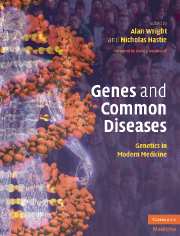Book contents
- Frontmatter
- Contents
- List of Contributors
- Foreword
- Section 1 Introductory Principles
- Section 2 Common Medical Disorders
- 13 Developmental disorders
- 14 Genes, environment and cancer
- 15 The polygenic basis of breast cancer
- 16 TP53: A master gene in normal and tumor suppression
- 17 Genetics of colorectal cancer
- 18 Genetics of autoimmune disease
- 19 Susceptibility to infectious diseases
- 20 Inflammatory bowel diseases
- 21 Genetic anemias
- 22 Genetics of chronic disease: obesity
- 23 Type 2 diabetes mellitus
- 24 Genetics of coronary heart disease
- 25 Genetics of hypertension
- 26 Obstructive pulmonary disease
- 27 Skeletal disorders
- 28 The genetics of common skin diseases
- 29 Molecular genetics of Alzheimer's disease and other adult-onset dementias
- 30 Major psychiatric disorders in adult life
- 31 Speech and language disorders
- 32 Common forms of visual handicap
- 33 Genetic and environmental influences on hearing impairment
- 34 Pharmacogenomics: clinical applications
- Index
- References
21 - Genetic anemias
Published online by Cambridge University Press: 17 August 2009
- Frontmatter
- Contents
- List of Contributors
- Foreword
- Section 1 Introductory Principles
- Section 2 Common Medical Disorders
- 13 Developmental disorders
- 14 Genes, environment and cancer
- 15 The polygenic basis of breast cancer
- 16 TP53: A master gene in normal and tumor suppression
- 17 Genetics of colorectal cancer
- 18 Genetics of autoimmune disease
- 19 Susceptibility to infectious diseases
- 20 Inflammatory bowel diseases
- 21 Genetic anemias
- 22 Genetics of chronic disease: obesity
- 23 Type 2 diabetes mellitus
- 24 Genetics of coronary heart disease
- 25 Genetics of hypertension
- 26 Obstructive pulmonary disease
- 27 Skeletal disorders
- 28 The genetics of common skin diseases
- 29 Molecular genetics of Alzheimer's disease and other adult-onset dementias
- 30 Major psychiatric disorders in adult life
- 31 Speech and language disorders
- 32 Common forms of visual handicap
- 33 Genetic and environmental influences on hearing impairment
- 34 Pharmacogenomics: clinical applications
- Index
- References
Summary
Introduction
Hemoglobin, the oxygen transporting molecule that makes up over 95% of the protein content of the red blood cell, has been at the forefront of research into the genetic causes of disease since the inception of such studies in the mid-twentieth century. In this short space of time, the normal structure and function of the molecule has been described in exquisite detail and accurate structure–function relationships have been derived from analyses of structurally abnormal hemoglobins. The thalassemias demonstrated a different class of disease-causing mutations, those resulting in defects in the synthesis of the globin polypeptides. Globin genes were among the first to be cloned and sequenced, providing an extensive list of mutations while functional studies of these genes have contributed enormously to our understanding of gene regulation. Application of this knowledge through prenatal diagnosis has made a major clinical impact on a growing number of populations and progress is being made in the development of gene therapy for the severe hemoglobin disorders. All in all, hemoglobin has provided a model system for the study of human genetic diseases.
Normal human adult hemoglobin (HbA, α2β2) is a tetrameric molecule consisting of two α-globin chains (141 amino acids) attached to two β-globin chains (146 amino acids). Each chain carries a prosthetic heme group that reversibly binds oxygen. The three dimensional structure of hemoglobin has been determined to a resolution of 1.7Å (Fermi et al., 1984), demonstrating a compact elliptical shape composed largely of α-helices.
- Type
- Chapter
- Information
- Genes and Common DiseasesGenetics in Modern Medicine, pp. 316 - 327Publisher: Cambridge University PressPrint publication year: 2007



